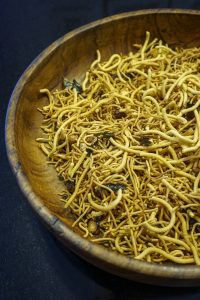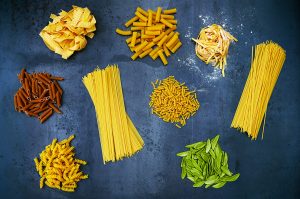The time reads 2:00 AM. I plod my way to the kitchen, open the pantry, and grab a packet of MAMA Noodles: Shrimp (Tom Yum) Flavor. I flick on the electric kettle, and cut open the noodles packet, emptying the contents into the bowl next to me. Click! I reach over and grab the handle of the kettle and tilt my head away from the steam as I pour the boiling water into the bowl. Dumping in the spice packet, I mix the noodles around, and saunter back to my desk. Waiting a couple minutes for the noodles to cool down, I twist a good amount on my fork, and take the first bite. Delicious. Now sit back, relax, and let me take you on the thousand-year journey that brought that mouth-watering bite of warm spicy noodles to the comforts of my home.
It was during the Han Dynasty in China that the noodle came to be, however at that time, it was more commonly referred to as cake. In the dynasties that followed, specifically the Wei, Jin, and Northern and Southern Dynasties, the composition and shapes of these noodles slowly increased, paving the way for two very unique kinds of noodles: Shui yin and Bo tuo. Greater varieties of noodles were soon introduced in the Sui, Tang, and Five Dynasty Periods, along with new methods and techniques for cooking these various types of noodles. Many types of exotic noodles emerged, such as Leng tao, which is a cold noodle, and Pig and sheep raw noodles. Some of the more famous noodles were brought to be in the Qing Dynasty, and these were the Five spicy noodles, as well as Eight treasure noodles. According to the article titled “Noodles, traditionally, and today”, these two types of noodles, “…were made of five and eight kinds of animal and plant raw material powder, respectively, and mixed into flour, which were considered top grade noodles” (Zhang 2016, 209).
Noodles in China not only represent the diversity in regions across China, but also the various cultural and traditional values of Chinese society. In China, food is used as a means to celebrate an important event or milestone in one’s life. For example, at birthdays, people usually eat longevity noodles, with the belief that this specific type of noodles will help them live longer. When two people get married, and eventually move in together, they celebrate by eating noodles with gravy which signifies a colorful, and vibrant married life. The Chinese eat different noodles for different occasions, seasons, and festivals. As China covers large territorial ground, and is made up of numerous regions, there are thousands of variations of noodles which are unique to each region. The differences in each noodle is based on the composition of it, the size of it, and the gravy seasoning used. While most noodles are made of flour, in the Southern province of Yunnan, noodles are made from rice. The diversity of Chinese noodles is linked to the diversity of each of its regions, and the people who cook them. Not only are the compositions of noodles varied across regions, but also the thickness of them. They can range from being, “as thick as chopsticks or as thin as hair, such as the dragon beard noodles” (Zhang 2016, 211). Noodles can also be classified by how they are made (i.e. hand-pulled or shaved noodles), as well as by the seasoning used (i.e. Beijing fried bean sauce noodles and Shandong noodles with gravy).
This diversity in noodles across the regions is not just unique to China; in fact, noodles in Italy are as diverse as they are in China. According to the article, Italy’s Cultural Heritage, “the most deeply rooted aspect of Italian cooking is that of its regional differences”. In the 8th Century, Arabic invasions of the Southern Peninsula of Italy greatly influenced the pasta in regions like Sicily. Many Sicilian pasta recipes incorporate predominantly Middle Eastern ingredients such as raisins and cinnamon, thanks to the presence of Arabic people in the South. As pasta spread to the mainland thanks to the abundance of durum wheat, the types of pasta that each region produced were varied. While the Romans unified Italy politically and via a common language, the regions of Italy remained unique in their, “local customs and provincial languages” (Italy’s Cultural Heritage). From the North to the South of Italy, the shapes and way pasta was cooked differed greatly. Nowadays there are over 300 different shapes and varieties of dry pasta across the Italian peninsula. According to the article, History of Pasta, the shapes of dry pasta range from tubes to bow ties, and even to shapes such as tennis rackets. These types of dry pasta were specifically designed for the purpose of grabbing and holding onto the rich, creamy sauces. Along with dry pasta, came fresh pasta which were made with slightly different ingredients. In the Northern regions of Italy, fresh pasta is prepared using all-purpose flour and eggs, whereas in the Southern regions, it is prepared using semolina and water. This only goes to further showcase the diversity in pasta across Italy. Not only is the way the pasta is prepared unique to the specific region of Italy, but so is the sauce used on the pasta. Fresh pasta is usually served with cream sauces, and a light tomato sauce for summer months, however in the Piedmont region, fresh pasta is usually served with a butter sauce complimented with local black truffles. The most important rule of Italian cooking is using fresh local ingredients, and this only further enhances the uniqueness of each pasta dish as the fresh ingredients used in each pasta dish is unique to the region they are grown in.
Similar to that of China and Italy, the type of noodle that one eats in India varies from region to region. However, unlike the noodles of China and Italy, which are usually cooked in boiling water, this specific type of Indian noodles is fried. Sev is a popular Indian snack food which consists of crunch fried noodles made from chickpea flour paste and seasoned with traditional Indian spices such as turmeric and ajwain. While they all can vary in thickness, similar to various types of pastas in Italy and China, sev is unique as it is deep-fried in oil to create that crunchy texture. The types of sev also vary from region to region in India. In Northern India, one would usually find sev mixed with chili powder, nuts and lentils, however in the Southern regions of India, sev is popularly mixed with sesame seeds and honey. Much like the noodles of Italy and China, the preparation, thickness, and taste of sev is unique to the region and people that make it.

I find it rather difficult coming up with a definition of noodles that successfully encompasses all the unique traditional, cultural and societal traits of China, Italy, India, and other countries that have adapted their own take on what the noodle is. However, for the sake of this assignment, I will do my best to define what noodles are. In my opinion, noodles are the glue that holds societies together. The glue that keeps traditions and cultures alive. The glue that defines differences, as well as similarities, in regions of countries. Lastly, the noodle is the glue that unites the world as it takes on various forms, shapes, sizes, textures, and most importantly, names.
Now on to the second bite of my delicious MAMA noodles…

The image that I chose represents the various shapes and sizes of pasta across the Italian peninsula. I found this image fascinating as it also highlights the versatility of pasta and the dishes that can be produced from the various local ingredients unique to regions in Italy.
Works Cited
Begg, Peter. “The Ultimate Guide to Pasta Shapes: Features: Jamie Oliver.” Jamie Oliver, Jamie Oliver, 12 June 2019, www.jamieoliver.com/features/the-ultimate-guide-to-pasta-shapes/.
Dada. “Sev.” Cuizine Maurice, 17 Sept. 2017, www.cuizinemaurice.com/2017/10/sev-en/.
“History of Pasta.” Life in Italy, 5 Nov. 2018, www.lifeinitaly.com/food/history-of-pasta.
“Italy’s Cultural Heritage.” The Classic Italian Cookbook, by Julia Della Croce, Reader’s Digest Association (Canada), 1996, pp. 8–17.
The Truth About Pasta. The International Pasta Organization, 2016, oldwayspt.org/system/files/atoms/files/TruthAboutPasta16.pdf.
Zhang, Na, and Guansheng Ma. “Noodles, Traditionally and Today.” Journal of Ethnic Foods, vol. 3, no. 3, 2016, pp. 209–212., doi:10.1016/j.jef.2016.08.003.
